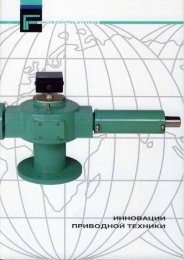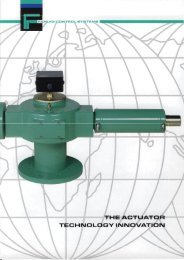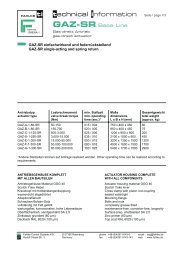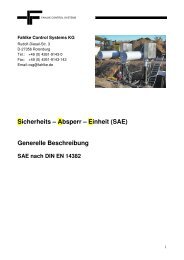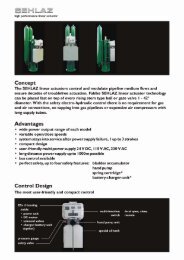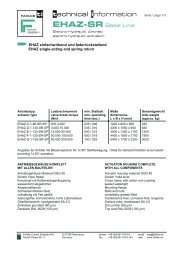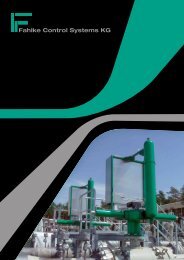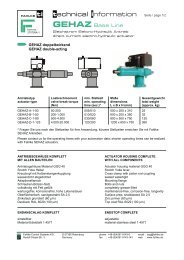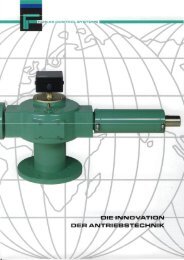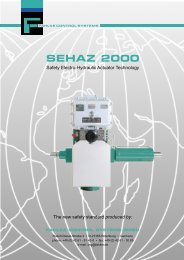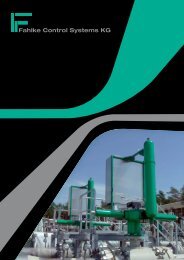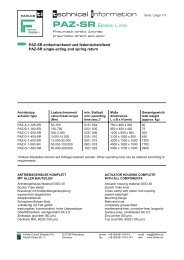LBC II - Fahlke Control Systems KG
LBC II - Fahlke Control Systems KG
LBC II - Fahlke Control Systems KG
You also want an ePaper? Increase the reach of your titles
YUMPU automatically turns print PDFs into web optimized ePapers that Google loves.
<strong>Fahlke</strong> <strong>Control</strong> <strong>Systems</strong> GmbH Germany<br />
Rudolf-Diesel-Str. 3 • D-27356 Rotenburg<br />
Tel.: (0 42 61) 91 43-0
THEORY OF OPERATION<br />
The <strong>LBC</strong> <strong>II</strong> watches the preselected pressure within a pipeline and shut down a valve whenever a<br />
pressure drop above a certain value is observed. This threshold depends on the operating conditions<br />
of the line, and must be determined in a way that it does not interfere with normal operational<br />
pressure drops.<br />
The common mechanical line break systems are not independent of some physical parameters like<br />
absolute pressure, dynamic viscosity, density and temperature of the linefill. By this reasons, the<br />
threshold for closing the valve can not be maintained precisely, and the user is forced to select a<br />
worst case limit. In some cases this must be a very rough estimation and makes the line break device<br />
too sensitive for practical use.<br />
The best way to detect a line break is to measure the pressure and to react on a certain pressure<br />
gradient. This can only be achieved by an electronic device. The transport-lines can lead pressure<br />
waves, which can simulate pressure drops, and this is why the selected gradient must be observed for<br />
a certain period of time to decide whether the change in pressure is tolerable or not. A gradient of 0,6<br />
bar/minute can also be a drop of 10 millibars per second, which is certainly a value which should be<br />
ignored. This example shows, that not only the pressure gradient but also the time span is significant<br />
for a system leak.<br />
The combination of the gradient and the observing time results in an absolute value of linefill that will<br />
be lost, in respect to the line length observed. These parameters must be discussed when fixing a<br />
limit for the gradient and reaction speed of the protective device. It is important to be aware of the<br />
fact, that the oil (gas) loss until the moment of reaction will be very small in comparison to the loss<br />
that will occure after closing a valve anyway, and that on the other hand the safety for a proper<br />
decision will increase with the observing time for the controller.<br />
The basic function of the processor is to measure the pressure and to shift the measured values into a<br />
buffer. Then it calculates the average of the two halves of the buffer and compares them, which gives<br />
the average of a pressure gradient within the measuring period. The selection of the gradient is done<br />
by means of a thumbwheel switch on the front panel of the processor. The gradient can be selected<br />
within the limit of 0,2 until 1,8 bar/minute.
MAIN COMPONENTS OF THE <strong>LBC</strong><br />
The <strong>LBC</strong> has the dimension of 105 x 90 x<br />
195 mm and will be delivered installed into<br />
a stainless steel box IP54 of 380 x 210 x<br />
600 mm which includes battery back up<br />
with charger unit, junction box, relay box<br />
and select switch.<br />
The supply for the processor can be<br />
adapted to practically all voltages. For AC<br />
supplies, a transformer will convert the<br />
input voltage to the internal supply of 12 V<br />
DC. When DC supply is given, a DC/DC<br />
converter is installed on the supply board<br />
of the processor. The power used to feed<br />
the processor is less than 200 milliwatt, that<br />
can also easily be done by a solar cell,<br />
which can be delivered by <strong>Fahlke</strong> as an<br />
option.<br />
In all cases the processor will be backed up<br />
by a battery that makes sure operation<br />
continues for a minimum of ten days after<br />
the power supply fails.
THE MICROPROCESSOR<br />
has its program stored in proms. This allows to match its characteristics in line with the customers demands.<br />
Even if the basic parameters required change, a reprogramming can be achieved by simply changing the proms<br />
on site, because they are not soldered into the printed circuit board, but only plugged into sockets.<br />
The design is based on long practical experience with various leak detection systems, therefore it is very likely,<br />
that hard- and software configuration will cover all practical applications for detection of leaks in oil- and gas-<br />
lines.<br />
The hardware has an indication panel where serveral<br />
parameters can be seen, like:<br />
a) gradient positiv,<br />
b) gradient negative,<br />
c) if the order for closing the actuator (valve) has<br />
been given and the actuator is still running into<br />
closed position,<br />
d) or if actuator and valve are already closed,<br />
e) indication if reopening the actuator (valve) is<br />
working,<br />
f) battery low alarm,<br />
g) malfunction indication<br />
h) and processor function indication.<br />
All of them are shown by LED signals on the display.<br />
The actual measured line pressure and the pressure<br />
gradient are both alternating shown on an extra LCD<br />
display.<br />
The lower part of the front also consists of a two<br />
decade thumbwheel switch for the selection of the<br />
pressure gradient.<br />
LEITUNGSBRUCH-DETEKTIONS-SYSTEM<br />
LINEBREAK-DETECTION-SYSTEM<br />
Anzeige<br />
indication<br />
<strong>LBC</strong> <strong>II</strong><br />
<strong>Fahlke</strong><br />
<strong>Control</strong> <strong>Systems</strong><br />
Gradient Positiv<br />
Gradient Negative<br />
Läuft zu<br />
traveling closed<br />
Befehl zu<br />
acting closed<br />
Freigabe auf<br />
reopening<br />
Batterie Alarm<br />
Störung<br />
malfunction<br />
Computer Funktion<br />
Druck / pressure<br />
Funktionsschalter<br />
function<br />
switch<br />
Gradient<br />
Gradient
INDICATION PANEL OF THE <strong>LBC</strong><br />
LEITUNGSBRUCH-DETEKTIONS-SYSTEM<br />
LINEBREAK-DETECTION-SYSTEM<br />
Anzeige<br />
indication<br />
<strong>LBC</strong> <strong>II</strong><br />
<strong>Fahlke</strong><br />
<strong>Control</strong> <strong>Systems</strong><br />
Gradient Positiv<br />
Gradient Negative<br />
Läuft zu<br />
traveling closed<br />
Befehl zu<br />
acting closed<br />
Freigabe auf<br />
reopening<br />
Batterie Alarm<br />
Störung<br />
malfunction<br />
Computer Funktion<br />
Druck / pressure<br />
Funktionsschalter<br />
function<br />
switch<br />
Gradient<br />
Gradient<br />
An analog output represents the line pressure,<br />
this output can be switched to give either 0 to 10<br />
V DC or 0 to 20 milliamps, a life zero output is<br />
optional.<br />
With a modem the complete status of the<br />
processor can be transmitted to a control center,<br />
which can be very useful to monitor the line<br />
pressure and open/close status of the valve.<br />
Commands can also be transmitted to the<br />
compressor, thus using the line break device as<br />
a simple telecommunication plant to telecontrol<br />
a valve.<br />
0 = P 70 bar<br />
1 = GRAD 70 bar<br />
2 = P/G 70 bar<br />
3 = P 40 bar<br />
4 = GRAD 40 bar<br />
5 = P/G 40 bar<br />
6 = <strong>LBC</strong> sends data to modem<br />
7 = failure signalisation output 20 mA<br />
8 = signalisation voltage battery<br />
9 = signalisation A/D transducer coefficient
FUNCTION OF THE CONTROLLER<br />
Switched on, the processor will release the open command, thus allowing the valve to go<br />
to the open position until the limit switch "open" is reached. A LED "open" will be lit for<br />
this period, to show, that the output transistor is activated and the valve should be<br />
running.<br />
The computer measures the pressure in the line in adequate points and shifts the values<br />
into a buffer. At every shift the oldest value is pushed out of the buffer. Whenever a new<br />
value is sampled, the averages of the two halves of the buffer are calculated and also the<br />
difference between both averages.<br />
The LCD display blinks and gives for a period of seven seconds the value of absolute<br />
pressure, then for three seconds the pressure gradient. Two of the LEDs are used to<br />
indicate whether the sign of gradient is positive or negative.<br />
When a pressure drop reaches the predefined threshold, the valve will be closed. During<br />
the closing period a LED also indicates the fact that a control output is energized.<br />
The closing function will also be executed, when the line pressure goes below a certain<br />
pressure (ppmax).
ILLUSTRATION NO. 1<br />
The thumbwheel switch on the front panel of the processor serves for setting the gradient that will<br />
close the valve when a leak is detected in the line. A gradient of this magnitude will close the valve<br />
after 60 seconds. When the leak is greater, the time for detection becomes shorter.<br />
The relation between size of the leak and the time used for detection is a non linear function, that is<br />
shown in illustration no. 1.<br />
P<br />
K: GR > S<br />
A V 2<br />
G R / 2<br />
A V 1<br />
30 30<br />
G<br />
t
1,2<br />
1,1<br />
1,0<br />
0,9<br />
0,8<br />
0,7<br />
0,6<br />
0,5<br />
0,4<br />
0,3<br />
0,2<br />
0,1<br />
S (bar / min.)<br />
10,0 5,0 3,0 2,0<br />
10 20 30 40 50 60<br />
gradient (bar/minute)<br />
1,2<br />
1,0<br />
G<br />
0,7<br />
0,4<br />
0,2<br />
t (s)<br />
ILLUSTRATION NO. 2<br />
The following table gives the appoximate<br />
values for different leaks<br />
and selected thresholds:<br />
threshold selected (bar/minute)<br />
0,2 0,4 0,7 1,0 1,2 2,0 3,0<br />
0,2 60 - - - - - -<br />
0,3 32 - - - - - -<br />
0,4 29 60 - - - - -<br />
0,5 26 33 - - - - -<br />
0,6 24 36 - - - - -<br />
0,7 22 32 60 - - - -<br />
0,8 20 29 39 - - - -<br />
1,0 18 26 36 60 - - -<br />
1,2 18 24 32 42 60 - -<br />
3,0 10 15 20 24 26 30 60<br />
response time (seconds)
PRESSURE MEASUREMENT<br />
For on-line pressure measurement the system is<br />
fitted with a piezoresistiv transducer (Kistler 4043<br />
A50). The transducer is feeded by 3 milliampere<br />
constantly, the measure signal will be taken as an<br />
voltage (0...500 MV) at the wheatstone bridge and<br />
will be prepared by a 12 bit analog digital<br />
converter.<br />
The complete error of the transducer is smaller than 0,5 % by the whole temperature range from -20 up to<br />
+80° Celsius. The longterm change is less than 0,2 % a year. That indicates the transducer works excellent<br />
for absolute pressure measuring. It is mounted in a way to be isolation proof for serveral kilovolts.<br />
The connection to the processor is a four wire connection: two wires to feed the bridge ( 3 milliamps),<br />
and another two to give back the measured voltage (0,375 volts). The function of the transducer is watched<br />
by the processor. If the transducer fails or a wire is interrupted, the processor will give an alarm via a light<br />
emitting diode and will stop operation immediately in order to avoid a wrong operation.
DIMENSIONS OF THE <strong>LBC</strong> COMPONENTS<br />
( 3 )<br />
D = 9<br />
( 4 )<br />
( 1 )<br />
250<br />
D = 6,8<br />
( 7 )<br />
( 6 )<br />
2 x PG 21<br />
1 x PG 13,5<br />
380<br />
( 2 )<br />
( 5 )<br />
<strong>LBC</strong> <strong>II</strong><br />
( 6 )<br />
1 x PG 21<br />
2 x PG 13,5<br />
1 x PG 13,5 / blue<br />
250<br />
600<br />
210<br />
1 = battery<br />
2 = terminal box<br />
3 = on-off switch<br />
4 = battery charger<br />
5 = microprocessor <strong>LBC</strong><br />
6 = cable glands<br />
7 = relay box<br />
The electronic line break system<br />
can also be mounted in an explosion<br />
proof cabinet if necessary.
acoustic<br />
alarm<br />
CPU<br />
BLOCK DIAGRAMM OF THE <strong>LBC</strong><br />
alarm<br />
LEDs<br />
RAM<br />
2 K<br />
LCD-pressure<br />
control<br />
UV-EPROM<br />
2.........6 K<br />
interface-controller<br />
autotest<br />
modem<br />
command open<br />
command close<br />
limit switch<br />
open actuator<br />
limit switch<br />
close actuator<br />
measurement UB<br />
telefon<br />
connection<br />
watchdog output<br />
analog-output<br />
0.........20 mA<br />
piezo<br />
pressure<br />
transmitter



